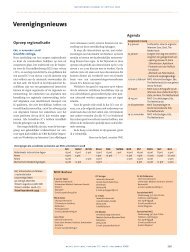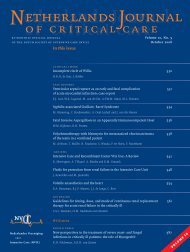Netherlands Journal of Critical Care
Netherlands Journal of Critical Care - NJCC
Netherlands Journal of Critical Care - NJCC
Create successful ePaper yourself
Turn your PDF publications into a flip-book with our unique Google optimized e-Paper software.
<strong>Netherlands</strong> <strong>Journal</strong> <strong>of</strong> <strong>Critical</strong> <strong>Care</strong><br />
Information for authors<br />
The <strong>Netherlands</strong> <strong>Journal</strong> <strong>of</strong> <strong>Critical</strong> <strong>Care</strong> (Neth J Crit <strong>Care</strong>) is the <strong>of</strong>ficial<br />
journal <strong>of</strong> the <strong>Netherlands</strong> Society <strong>of</strong> Intensive <strong>Care</strong> (Nederlandse Vereniging<br />
voor Intensive <strong>Care</strong>-NVIC). The journal has a circulation <strong>of</strong> about 1,750 copies<br />
bimonthly in the <strong>Netherlands</strong> and Belgium.<br />
High quality reports <strong>of</strong> research related to any aspect <strong>of</strong> intensive care<br />
medicine, whether laboratory, clinical, or epidemiological, will be considered<br />
for publication in the Neth J Crit <strong>Care</strong>. This includes original articles, reviews,<br />
case reports, clinical images, book review, structured abstracts <strong>of</strong> papers<br />
from the literature, notes, correspondence etc. All manuscripts pass through<br />
an independent review process managed by the editorial board.<br />
The journal is indexed by Embase, Emcare and Scopus. A Medline annotation<br />
is in prepara tion. The following manuscript types apply.<br />
Structured abstracts<br />
All manuscripts should be submitted with structured abstracts as described<br />
below. No information should be reported in the abstract that does not<br />
appear in the text <strong>of</strong> the manuscript.<br />
Manuscripts should include an abstracts <strong>of</strong> no more than 300 words using the<br />
following headings: Background and objectives, Design, Methods and results<br />
and Conclusions. For the sake <strong>of</strong> brevity, parts <strong>of</strong> the abstract may be written<br />
as phrases rather than complete sentences.<br />
Background and objectives<br />
State the precise primary objective <strong>of</strong> the review. Indicate whether the review<br />
emphasizes factors such as cause, diagnosis, prognosis, therapy, or prevention<br />
and include information about the specific population, intervention, exposure,<br />
and tests or outcomes that are being reviewed.<br />
Design<br />
Describe the design <strong>of</strong> the study indicating, as appropriate, use <strong>of</strong> randomization,<br />
blinding, gold standards for diagnosis test and temporal direction (retrospective<br />
or prospective).<br />
Methods and results<br />
Summarize here accurately, although concisely, summarize how you will<br />
proceed in learning the answer to the objective. Also provide the main<br />
outcomes <strong>of</strong> the study.<br />
Conclusions<br />
The conclusions and their applications (clinical or otherwise) should be<br />
clearly stated, limiting interpretation to the domain <strong>of</strong> the review.<br />
Original articles/reviews<br />
Articles should describe original investigations that have been brought to an<br />
acceptable degree <strong>of</strong> completion. Articles should not exceed 3000 words. The<br />
editorial board also welcomes review papers which should also not exceed<br />
3000 words.<br />
The manuscript should be clear in outline (with subheadings) for maximum<br />
clarity. Only a limited number <strong>of</strong> figures (coloured figures are encouraged<br />
without extra charge) and tables may be included; double presentations in<br />
the form <strong>of</strong> figures and tables should be avoided. The text should follow<br />
the IMRAD format and contain an abstract, introduction, materials and<br />
methods, results, discussion section and references. The abstract should<br />
not exceed 250 words and should be structured. Authors should provide<br />
a minimum <strong>of</strong> three keywords, a running title, and list not more than 30<br />
references for original articles and 70 references for review articles.<br />
Case Reports<br />
The text <strong>of</strong> a case reports should also include an abstract, introduction, case<br />
report/case history, discussion section, legends for figures and references. The<br />
abstract should not exceed 250 words and may be unstructured. The journal<br />
kindly requests authors to provide a minimum <strong>of</strong> three keywords and to list<br />
not more than 30 references.<br />
Clinical Images<br />
A clinical image should contain one or two pictures and a short case history,<br />
and should preferably not be referenced. The legend to the image should<br />
succinctly present relevant clinical information, including a short description<br />
<strong>of</strong> the patient’s history, relevant physical and laboratory findings, clinical<br />
course, response to treatment (if any), and condition at last follow-up. The<br />
journal kindly requests authors to provide a minimum <strong>of</strong> three keywords.<br />
General information<br />
The original manuscript and two copies (or electronic file) are to be submitted<br />
to the editor in chief at the NVIC <strong>of</strong>fice by e-mail (see below). The manuscript<br />
must be accompanied by a cover letter stating the following: the complete<br />
mailing address, e mail address, telephone number and fax number <strong>of</strong> the<br />
corresponding author, and if it is a re submission, the previous Neth J Crit<br />
<strong>Care</strong> number and year. Receipt <strong>of</strong> the manuscript will be acknowledged<br />
in writing within 14 days. If this is not the case, authors are requested to<br />
check. The language <strong>of</strong> the journal is British English. Authors who are unsure<br />
<strong>of</strong> proper English usage will have their manuscript checked by someone<br />
pr<strong>of</strong>icient in the English language.<br />
Layout<br />
Paragraphs starting immediately under headings and subheadings should<br />
begin at the left margin. Subsequent paragraphs should be indented. All text<br />
should be double spaced, on one side <strong>of</strong> the paper and with a wide margin.<br />
The manuscript pages, including references and legends, must be sequentially<br />
numbered throughout.<br />
Tables<br />
Tables are to be numbered independently <strong>of</strong> the figures with Arabic numbers,<br />
with headings and kept separate from the text.<br />
Figures<br />
Figures must also be numbered with Arabic numbers and kept separate from<br />
the text. Legends must be given on a separate sheet. Schematic line drawings<br />
are preferred. Figures already published elsewhere cannot usually be included,<br />
except in survey articles. Colour figures can be published. Short, clear legends<br />
make additional description in the text unnecessary. The desired placement<br />
<strong>of</strong> figures and tables can be marked in the margins <strong>of</strong> the manuscript sheets.<br />
Figures should be provided in electronic format TIFF or better.<br />
References<br />
Only articles cited in the text are to be listed. They are to be arranged in order<br />
<strong>of</strong> appearance in the text …. and numbered consecutively. Only the reference<br />
number should appear in the text. Include all author names (unless there are seven<br />
or more, in which case abbreviate to three and, add ‘et al.’), and page numbers.<br />
Article in journals: Calandra T, Cometta A. Anti biotic therapy for gram negative<br />
bacteremia. Infect Dis Clin North Am 1991;5:817-34<br />
Books (-sections): Thijs LG. Fluid therapy in septic shock. In: Sibbald WJ, Vincent<br />
J L (eds). Clinical trials for the treatment <strong>of</strong> sepsis. (Update in intensive care and<br />
emergency medicine, volume 19). Berlin Heidelberg New York, Springer, 1995,<br />
pp 167-190. Conference Meetings: Rijneveld AW, Lauw FN, te Velde AA, et al.<br />
The role <strong>of</strong> interferon gamma in murine pneumococcal pneumonia.<br />
38th Interscience Conference on Antimicrobial Agents and Chemotherapy<br />
(ICAAC). San Diego, Ca., 1998, pp 290<br />
Copyright<br />
Copyright ownership is to be transferred in a written statement, which must<br />
accompany all manuscript submissions and must be signed by all authors.<br />
The agreement should state, “The undersigned authors transfer all copyright<br />
ownership <strong>of</strong> the manuscript (title <strong>of</strong> article) to the <strong>Netherlands</strong> <strong>Journal</strong> <strong>of</strong><br />
<strong>Critical</strong> <strong>Care</strong>. Authors must disclose any potential financial or ethical conflicts <strong>of</strong><br />
interest regarding the contents <strong>of</strong> the submission. Any relevant papers that may<br />
be considered as duplicating in part the current submission should be reported.<br />
How to submit<br />
Submit manuscript directly to: Editorial <strong>of</strong>fice e-mail: nethjcritcare@nvic.nl<br />
Neth j crit care – volume 17 – no 1 – february 2013<br />
39







